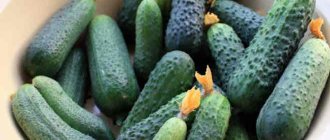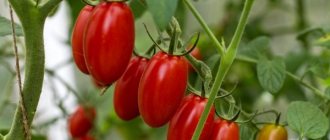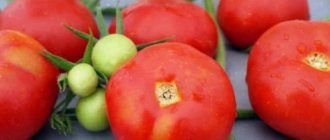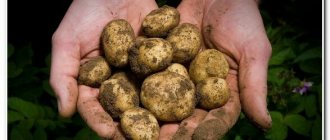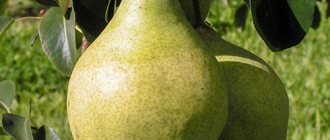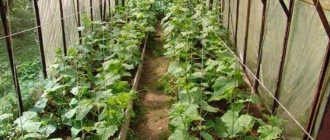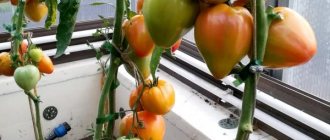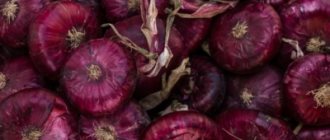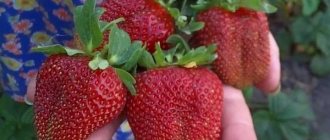The Skorospelka tomato belongs to determinant varieties intended for cultivation in open ground, although it produces no less yield in greenhouse conditions. The plant is not characterized by high productivity, but is unpretentious and allows you to collect red, flat-round fruits weighing up to 150 g after 87-95 days from the moment of germination.
Tomato seeds “Skorospelka”
Tomato variety “Skorospelka”
During fruit ripening, the area near the stem is orange.
Description of the variety
Early ripening is a low-growing plant belonging to ultra-early ripening varieties, which explains its name. We will look further at the main qualities of bushes and fruits.
Bushes
They are spreading and reach a height of about 50-70 cm, but when grown in greenhouses they can grow up to 1 m, so they need to be tied to a strong support and additional pinching (removing or shortening second-order shoots - stepchildren).
Tall, branched stems bear copious amounts of ash-green, fleshy foliage. The inflorescences of the plant are simple, and the flowers are shaped like small bells and have a bright white color with a characteristic yellow base. Fertility averages 6-7 fruits per branch.
Fruit
They ripen on 87-95 days from the moment of emergence, have a medium size and a flat-round shape (slightly flattened at the ends). Their average weight is 150 g. When ripe, one side of the tomato has an orange tint, while the rest of the fruit is bright red.
For an ultra-early ripening variety, the fruits are moderately sour and fleshy with a high content of biologically active substances. They are universal, so they can be used fresh for preparing early salads. Later fruits are more suitable for preservation. Tomatoes of this variety are not afraid of high temperatures, so they do not burst during processing. So, you can make excellent tomato juice from them.
The fruits are distinguished by good keeping quality and transportability, which is due to their high density and fleshiness. In this regard, gardeners often grow this variety for commercial purposes.
Characteristics table
The main characteristics of Skorospelka can be found in the table:
| Parameter | Description |
| General qualities | An ultra-early ripening and low-growing variety that can grow and bear fruit in open ground and in a film greenhouse. When breeding in Siberia and the Far North, it is better to plant in greenhouses or well-heated greenhouse complexes. |
| Ripening period | 87-95 days after emergence |
| Form | Flat-round |
| Color | Bright red |
| Weight | Reach up to 150 g |
| Application | Suitable for fresh consumption, as well as for processing and preservation. |
| Productivity | From 1 sq. m of planting area, you can collect about 5-7 kg of fruit. On average, up to 7 tomatoes are formed on one bush. The yield is low due to the fact that the variety is early. |
| Features of cultivation | Requires pinching and tying to a strong support. |
| Disease resistance | Resistant to major diseases. Due to its early ripening, the tomato ripens before the onset of late blight. |
| Variety values | It produces a stable harvest and has good fruit set even at low temperatures. |
The characteristics of the low-growing variety are also described in the video:
Farmer reviews
The experience of farmers cultivating early ripening on an industrial scale has shown tomato yields of 5-7 kg of tomatoes per 1 sq.m of planting . The fruits of the “Skorospelka” variety are most often used for the production of tomato juices.
In reviews of the “Skorospelka” tomato, gardeners note the high quality of the resulting preservation and the early timing of the first harvest.
Elena: “I bought the seeds according to the description, I had no growing experience. The result is excellent - the taste of canned tomatoes is beyond praise. At the same time, the fruits almost did not burst. I’ll plant again next year.”
Vladimir: “If you need an early variety, you won’t find better than Skorospelka. This is the third year I’ve been planting seedlings of these tomatoes and I always get a harvest before my neighbors in the country.”
Agricultural technology
To successfully grow tomatoes, you must meet a number of requirements:
- Prepare seedlings 55-60 days before they are supposed to be planted in the ground. As a rule, this period falls at the end of March.
- For Skorospelka, sandy and loamy soils with a pH in the region of 5-6 are optimal. Its best predecessors are cucumbers, cabbage and all types of beans.
- Maintain plenty of light as tomatoes love light. The brighter and more intense it is, the more actively the fruits will ripen. The lack of light will lead to stretching and weakening of the bushes, as a result of which the beginning of their flowering and fruiting will be delayed.
- In order for the seeds to begin to germinate, the temperature must be maintained within +14...+16°C, although its best indicators are +20...+25°C. If it drops to +10°C, the development and growth of the plant will slow down significantly and may stop altogether with a further drop in temperature. If it reaches -1°C, the plant will die completely.
- For positive plant development, maintain air humidity at about 45-60%, and soil humidity at 65-75%.
- During the growth of the plant, maintain the fertility of the soil cover, since the formation of fruits, which receive most of the useful elements from the soil, depends on it. So, at the stage of formation of the root system it is worth introducing phosphorus fertilizers, and at the stage of fruit formation - complex fertilizers with phosphorus and potassium. Particular care must be taken when handling nitrogen fertilizers for two reasons:
- a lack of nitrogen will lead to slower plant growth, discoloration or even falling of leaves, and the appearance of small fruits with defects;
- Excess nitrogen will provoke excessive growth of foliage and stems, as a result of which the yield of the variety will suffer and the process of fruit formation will slow down.
In addition to fertilizing with complex mineral fertilizers, in order to obtain a good harvest, the plant must also be watered on time, fertilized and preventive measures must be taken to protect it from pests and diseases.
Classification by growth type
- Superdeterminant. Growth stops after the formation of the third brush.
- Standard ones. Dense compact bush, strong trunk allows cultivation without supports or garters.
- Determinant. Weak-growing, up to 5 flower clusters are laid.
- Semi-determinant. The maximum number of fruit clusters is up to 12.
- Indeterminate. Growth is unlimited. The rate of flowering and formation of ovaries will be extended until the end of the growing season.
For regions with short daylight hours, it is advisable to choose an assortment from the first three groups. They will ensure rapid production of a full harvest at the beginning of the summer season and avoid mass damage by late blight during fruiting.
How to buy seedlings?
Growing seedlings from seeds is one of the most important stages of tomato breeding and requires a lot of time. If there is a shortage of it, seedlings can be purchased, taking into account the following factors:
- The seedlings should be no more than 60 days old. In this case, the best option is young sprouts over 45 days old. It is important that all purchased seedlings are of the same age, otherwise they will grow unevenly in the garden bed and will not be able to provide neighboring plants with natural protection from the scorching rays of the sun.
- The optimal height of seedlings is up to 30 cm, and the number of leaves is from 6 to 8.
- The stem should be elastic and thick, resembling a pencil in its parameters.
- There should be no visible mechanical damage on the leaves, stem and roots. In addition, there should be no oviposition of various pests on the trunk and leaves. For small insect eggs, you need to especially carefully examine the back side of the leaves and the places where the branches are attached to the trunks.
- Seedlings should be symmetrical with a well-developed and compactly formed root system.
- All seedlings should be in boxes with soil, and not in bags, since this method of packaging can lead to damage to the root system, which will disrupt its normal and rapid rooting in the garden bed.
Unscrupulous sellers accelerate the growth of seedlings by introducing excessive amounts of nitrogen fertilizers. Such seedlings will be distinguished by their intense green color and leaves, the tips of which will be turned inward.
Preparing seedlings with your own hands and planting in open ground
Many gardeners prefer to grow their own seedlings from the end of March. This process consists of several stages:
- Preliminary processing . After purchasing, the seeds need to be germinated. First of all, fill them with water and leave for a while. Those that float up must be removed and destroyed, and the seed material at the bottom must be disinfected by soaking in a weak solution of potassium permanganate (1 g per 1 liter of water), which should have a light pink color. To disinfect seeds, you can use other means, including an ash solution (2 tablespoons of ash per 1 liter of boiling water, soak for 2 days) or the drug Fitosporin-M, which improves germination and increases the immunity of tomatoes.
- Soil preparation . Mix soil, peat and sand in a ratio of 1:1:1, and then place the mixture in small boxes or plastic containers and add manure to it. The substrate must be disinfected by heating it in the oven.
- Planting seeds . Plant them to a depth of 15 mm, and then water them with warm water and cover them with film. Keep in a warm place until shoots appear, and then move to a bright place and remove the film. The first shoots appear on days 3-5, after which the seed container must be moved to a bright place.
- Feeding . Sprouts will appear 6-7 days after sowing. Seedlings need to be fed with fertilizers. Read more about this here.
- Picking . On days 15-21 or after 2 adult leaves appear on the seedlings, carry out a dive so that the plant becomes stronger and stronger. When planting tomatoes, deepen them to the cotyledon leaves. Keep them in the shade from sunlight for 3-4 days so that the sprouts can adapt after transplantation.
- Maintaining an optimal microclimate . During the daytime, the temperature should be maintained around +20...+25°C, and at night – not lower than +18°C. If the spring is cloudy, it is necessary to extend natural daylight hours with the help of fluorescent lamps. When growing tomatoes in a greenhouse, it is also important to monitor air humidity and regularly ventilate the room.
- Watering. When the soil cover dries out, the seedlings should be watered moderately, taking into account that excessive moisture will lead to the development of blackleg. The soil should also not be overly moistened when applying various fertilizers.
Seedlings receive all the necessary microelements from the soil, so if they look healthy and strong, and the leaves have a characteristic dark green tint, then they do not need any fertilizers.
- Hardening . It is carried out 12 days before planting seedlings in open ground. To harden seedlings, they need to be taken out into the fresh air in a closed loggia or outside for several hours every day.
You can learn more about when and how to properly plant tomatoes for seedlings in our other article.
When the seedlings are 55-60 days old, they can be transplanted into open ground. To promote the rapid growth of tomatoes, in the fall, closer to October, it is worth planting green manure, for example, peas, in the garden bed. In the spring, 10-15 days before starting work with seedlings, its greens need to be mowed, chopped and dug into the soil to fertilize it with all the necessary organic matter.
The transplantation of seedlings to a permanent place should be carried out according to the 0.3x0.5 m scheme at the rate of 5-6 plants per 1 square meter. m. First, the soil on the site must be loosened, disinfected with potassium permanganate, manure and nitrogen fertilizers applied.
Read about growing tomatoes in open ground here.
Growing Siberian early ripening tomato
Like most other varieties of tomatoes, Siberian early ripening is preferable to grow through seedlings. Approximately two months before the expected planting day (in the ground on the site), sowing is carried out.
This time usually falls on the last days of February or the first week of March. It is recommended to pre-soak the seed material in a solution of any root formation stimulator (Heteroauxin, Epin, etc.), then germinate it, wrapped in several layers of damp cloth or spread between cotton pads.
Plastic containers or boxes are filled with nutritious soil mixture purchased in the store (any universal seedling mixture will do) or prepared independently from the following components:
- 2 parts garden soil or turf;
- 2 parts compost or humus;
- 1 part sand (sifted and washed).
The swollen and sprouted grains (the seeds of the Siberian early ripening can be bought or collected yourself) are laid out in shallow (0.5-1 cm) grooves and sprinkled with soil. Then the crops are carefully moistened with a spray bottle and the containers are covered with transparent glass or film, creating an impromptu mini-greenhouse.
Keep in a bright (directly falling sunlight is contraindicated) and fairly cool (+15...+16 °C) place. As soon as the first shoots emerge, the protective cover is removed and the containers are moved to the sun, providing at least 15-16 hours of daylight. The temperature is raised to +20…+23 °C.
If necessary, tomatoes are additionally illuminated with fluorescent or phytolamps.
Seedlings of Siberian early ripening at the stage of 2-3 true leaves dive into individual cups.
Further care is very simple, it consists of regular moistening (the soil should not dry out completely) and periodic fertilizing (you can use universal mineral compositions).
Ready grown tomato seedlings are moved to the site when the average temperature fluctuates around +15 °C (May and even early June) and the risk of frost return is minimal.
For better adaptation, Siberian early ripening seedlings are hardened off for two weeks, taking them out into the fresh air and accustoming them to sunlight.
The soil for tomatoes is prepared in advance, the selected area (open and sunny) is well dug up, simultaneously adding (per 1 m2):
- humus - 10 l;
- superphosphate - 40-45 g;
- infusion of chicken manure (1:20) - 10 l;
- ash - 100-150 g.
Make planting holes about 20-25 cm deep, placing them according to a 30*50 cm pattern. Then tomato seedlings are planted in them, placing 3-4 bushes on each m2. To reduce moisture consumption, it is recommended to mulch the plantings with straw, peat, humus, grass cut from the lawn, etc.
Subsequent care measures for Siberian early ripening do not have any fundamental differences from caring for other varieties of tomatoes and include:
- Regular and fairly abundant watering (at least once every 5-6 days).
- Timely removal of weeds, as well as loosening the soil between rows and under bushes (after each moistening).
- Feeding. During the period of active and rapid growth of tops - nitrogen-containing compounds (urea, mullein infusion, etc.). Then, every 10-14 days, tomato plantings are fertilized with universal complexes (Kristallon, Krepysh, Kemira, etc.).
- Stepsonning. Most often, Siberian early ripening is grown in 2-3 stems. To do this, 1 or 2 strong lateral shoots are left under the very first flower cluster; all others are mercilessly torn off when they reach 3-4 cm. The shoots must be tied to supports in a timely manner, as they can fall under the weight of the filling fruits.
Siberian early ripening can also be grown using the seedless method, when the seeds are sown directly on the garden bed. The harvest ripens a little later, but the tomatoes are larger, tastier and more aromatic.
You should not give up tomato varieties that have been proven for decades, reliable, unpretentious and guaranteed to yield, such as Siberian early ripening. In terms of the total mass of harvested fruits, they are clearly inferior to the latest modern hybrids, but they are easy to care for and not so capricious. An acceptable harvest of tomatoes can be obtained from them even in the most unfavorable weather situation.
Maintenance and care
To obtain a good harvest, seedlings must be properly cared for, performing all agrotechnical practices on time. Let's look at what they are next.
Watering
It is carried out once a week in dry weather and less often in rainy weather. The best time to moisten the soil is morning or evening. You need to use warm water that has stood in the sun.
It is worth watering the tomato by drips so that a little moisture is constantly retained under it. Thanks to this, the harvest will be large, and the fruits will grow fleshy and elastic.
After moistening the soil, you need to wait until the top layer becomes crusty, and then fluff up the soil around the bushes, otherwise a “stone” crust will form, which can harm the stem and roots, since it will interfere with the nutrition of the soil.
You should not overdo it with watering, since a large amount of moisture will cause cracks in the fruit. They are dangerous because infectious lesions can penetrate into them, causing the tomato to rot.
Loosening and hilling
The soil needs to be loosened 3-4 times a week, and hilled 2-3 times per season. In addition, it is important to regularly weed and remove weeds, otherwise parasites will remain on the roots of the plants, which can cause fungal or bacterial diseases.
Top dressing
The plant can be fed with any special mixtures that contain more potassium and phosphorus than nitrogen. They need to be applied no more than 2 times a week and at least 3 times a season. In addition, the tomato can be watered with water in which chicken droppings have previously been dissolved.
Among mineral fertilizers, mixtures with a high content of boron and magnesium are especially useful. For example, the plant can be watered with a solution of boric acid (1 g per 1 l).
Tying up
It is an important phase in plant care. It is carried out with the appearance of 6-7 leaves, that is, almost immediately after planting the seedlings in a permanent place. Tying can be done in one of two ways:
- tie each bush to a separate peg, which must be driven in at a distance of 10 cm from the stem, and from the north side;
- use a trellis with sparse support posts, between which wire is stretched.
It is believed that the second method is optimal, since bushes from two rows can be tied in pairs to one trellis. Thanks to this, you can free up the passage between them, which will greatly facilitate harvesting.
The experience of gardeners has shown that when bushes are tied to a trellis, the fruits are larger than when they are tied individually to a peg.
Stepsoning
It is carried out 7 days after planting the seedlings on the site. Stepchildren need to be removed before their length reaches 3-4 cm. The fact is that removing a shoot of greater length can lead to undesirable consequences and even the death of the plant. Stepchildren need to be removed every week, otherwise the bushes will grow greatly.
Protection from pests and diseases
If the garden has been attacked by pests (aphids, Colorado potato beetles, caterpillars), they need to be eliminated using special chemicals. If these are not available, you can use copper sulfate or soap solution. It needs to be sprayed on the leaves and stems of the plant.
The following pests can cause particular harm to tomatoes:
- Slugs . They eat leaves and provoke the development of rot on fruits. Ash, tobacco dust, and slaked lime will help against them. The selected product should be sprinkled around the stem.
- Spider mite . It entangles the foliage in a web, sucks the juice out of it, causing it to dry out and the plant itself may die. Infusion of garlic or Karbofos will help against ticks.
- Medvedka . By destroying the root system, it leads to the death of the plant. To destroy it, you can use an infusion of hot pepper with vinegar or Thunder.
- Wireworm . The bright yellow larva that eats roots often burrows deep into the stem. It can be destroyed by Bazudin.
- Gnawing owls . A dark gray or black caterpillar that destroys foliage and stems. To get rid of it, the plant can be sprayed with Arrow.
- Whitefly . The insect appears on the greenery and covers it with secretions, which provokes the development of fungi. After this, the bush turns black and dies. Confidor can be used against insects.
As for diseases, the most dangerous among them are:
- Streak . Leads to curling and lethargy of leaves, falling off of all flowers and fruits, and in severe cases, the death of the plant itself. To prevent the virus, seedlings should be transplanted to a sunny place and away from other crops of the nightshade family.
- Verticillium wilt . The leaves turn yellow below, dry out and fall off, and the plant stops growing, but does not die. To prevent the development of the disease, diseased bushes must be removed.
- Late blight . The entire plant is covered with numerous putrefactive spots, and the lower part of the foliage is covered with a whitish coating. Proper feeding and compliance with neighborhood rules will help prevent the disease. If it affects the plant, then it must first be sprayed with Barrier, and after a week - with Barrier. Among folk remedies, garlic infusion (5 crushed cloves per 1 liter of water) has proven itself well.
- Fomoz . Large purple spots up to 3-4 cm in diameter appear on the tomatoes. The affected area appears concave, since putrefactive processes also affect the pulp. The disease develops due to excessive humidity. If it has already been identified, the affected fruits should be removed and the bushes should be sprayed with Bordeaux mixture, Hom or Oksikhom.
- Bacterial spotting . Small brown spots appear on the foliage, and large depressed spots with a border in the form of a light border appear on the fruits. Threatens the complete death of the plant. To prevent the disease, you need to apply fertilizers containing copper and nitrogen on time. If spotting appears, the plant must be treated with Bordeaux mixture or copper sulfate. It is better to remove wilted bushes.
- Black leg . It mainly affects seedlings and young seedlings. The infection manifests itself as black spots on the stem and wilting of the plant. To prevent disease, the plant should be watered moderately, and sometimes a solution of potassium permanganate (1-1.5 g per 10 liters of water) should be used for this.
How to harvest and store the crop?
Harvesting can be done as early as June. If you plan to eat tomatoes fresh, as well as use them for canning, making tomato juice or paste, it is better to pick them at the moment when they are fully ripe and turn red. This occurs 80-90 days after sowing the seeds. If you plan to salt or store Skorospelka, the fruits can be collected earlier, when they are still green, milky or pink.
Before storing, sorting should be carried out, identifying and removing fruits with mechanical or other damage. The densest and most elastic tomatoes should be placed in plastic or wooden boxes so that each of them weighs no more than 12 kg. They should be kept in a dark and cool place, such as a basement or pantry. However, it should not be damp, since in this case fungal and putrefactive lesions will appear on the tomatoes. To prevent damage to the crop, the room must be regularly ventilated, for example, by opening the doors for several hours.
Early ripening is a fleshy and elastic variety, so tomatoes retain their original shape for a long time. However, you should not forget about them for a long time so that they do not deteriorate. So, they should be used for their intended purpose in the coming weeks after harvest.
Selected tomatoes can be transported in boxes to prevent them from choking and leaking juice.
Germination of seeds
To plant tomatoes, seedlings are first grown. Prepared seeds are placed in pots or special containers with soil.
Planting material can be left from last year or purchased, paying attention to the quality of the product and shelf life. Preparation of tomato seeds includes the following work:
- Sorting. Only large healthy seeds are suitable, they contain more nutrients, and strong plants grow from them.
- Warming up is necessary if storage was at low temperatures. Performed 1-1.5 months before planting for a week. Seeds folded in fabric bags are placed on the radiator for several days.
- Disinfection. It is believed that many bacteria can even be on the surface of the grains, so they are subjected to pickling. A 1% solution of potassium permanganate is suitable for the procedure.
- Soaking in a nutrient solution, biostimulant (for example, Epine, Immunocytophyte) according to the instructions, after which the planting material is dried.
- Soaking - the seeds in the bag are immersed in warm water at room temperature for a maximum of 10-12 hours. The liquid is changed periodically, the seeds are taken out every 4 hours so as not to suffocate.
- Pre-germination promotes earlier appearance of sprouts, improves germination, and promises early fruit production. Cover the saucer with wet gauze, lay out the seeds, make sure that the fabric does not dry out, and excessive moisture is also not allowed.
- Hardening increases the resistance of tomatoes to adverse weather conditions. Hatched seeds in a damp cloth are placed at the very bottom of the refrigerator for 10-12 hours, and kept at 16-20°C during the day. Repeat this procedure for several days.
Germinating seeds are planted to a depth of about 1 cm, several pieces in containers for seedlings at room conditions or bred in a greenhouse. As sprouts and full-fledged leaves appear, weak small units are removed. For proper growth, development and ripening of fruits, tomatoes need a well-lit area.
Siberian early ripening in open ground
Advantages and disadvantages
The advantages of the variety look like this:
- bears fruit even with temperature changes, which often occur in April and May;
- has good immunity and is resistant to many diseases;
- does not encounter late blight due to its early ripening;
- It is distinguished by friendly yield and unpretentiousness.
As for the disadvantages, the following should be noted:
- requires stepsoning;
- bushes need to be tied to a support;
- productivity is relatively low.
Skorospelka is an early tomato variety that is recommended for growing in open ground, but also bears fruit well in greenhouse conditions. The plant is unpretentious, and the main care for it consists of regular watering and feeding. To get a good harvest, you also need to remember about pinching and tying to a support.
0
0
Copy link
Syzran early ripening
Early ripening is the earliest. This Syzran tomato variety has powerful bushes and long-term fruiting. The species belongs to the semi-determinate type - the plant reaches 150 cm in height. It is recommended to pin it and tie it to a support. It would be preferable to form 1-2 stems. Suitable for growing both in greenhouses and in open ground. The variety is a beautiful red, sugary, plum-shaped fruit with a sharp nose and no sourness. The average weight is 100-200 g. The berries are suitable for both fresh slicing and canning. An excellent advantage is the possibility of long-term transportation and storage. With proper agricultural care, the yield of one bush reaches 3.5 kg.
